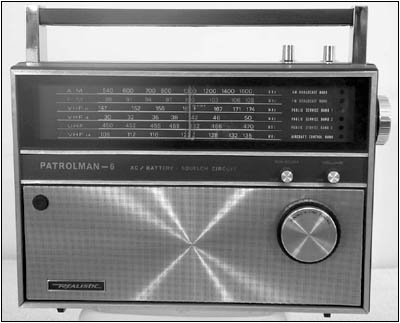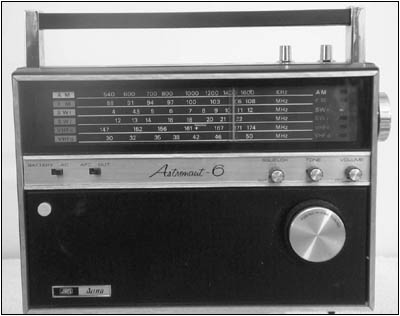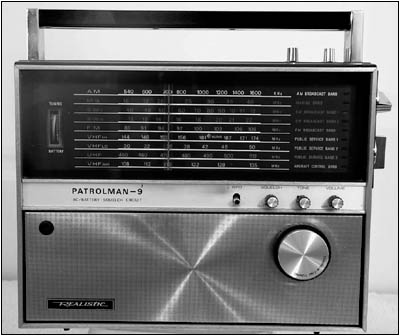Of Old Radios And Related Items--Published Monthly
Transistorized Multiband Portable Radios
BY CHARLES STADLER
WEB EDITION
Radio collecting is such a broad field that most collectors home in on a particular specialty. In Charles Stadler's case, he has chosen multiband portable radios. Here he describes the subtle variations in some Radio Shack's Realistic lines from the 1970s and 1980s. (Editor)
It is 50 years since the Regency TR-1 transistor radio was sold in 1954. This would definitely make "antique" a proper term for those old transistor radios. By the end of the 1960s, a decade and a half later, one would be hard pressed to find a tube radio, portable or table. The advantages of transistors had helped change the styles and designs of electronics. Smaller packages could easily accommodate more bands and quality for lower costs.

Figure 1. The first in the series of Patrolman 6 radios was this 12-756 from 1973. In addition to AM and FM, this radio tuned the High and Low VHF bands, the VHF Air band, and UHF (450-470 MHz).Looking through catalogs, such as Montgomery Ward, Lafayette, and Radio Shack (Allied), provides a look at a wide range of portable radios available from a variety of sources. It was not hard to find radios with wide frequency coverage. A quick search through eBay shows that many of these radios are still available.
Radio Shack Patrolman Series
I like to collect multiband portable radios. Further, I like to find radios that belong to sets or series. One such series is the Radio Shack Patrolman series. These radios featured VHF coverage in addition to AM or FM coverage. The first units -- 12-628, 12-629, and the Patrolman Mini 12-622 -- appeared in the early 1970s. They were pocket radios which featured the VHF High band.
Over the years, bands were added, starting with the Patrolman 3 (3 bands with UHF added) and the Patrolman 10 (10 bands -- shortwave to UHF coverage) in 1974, and ending with the Patrolman SW-60 (6 bands) introduced in 1984 and shown in catalogs until 1990.

Figure 7. The 1973 Astronaut 6 (12-5060) has a case style similar to the Patrolman 6, but it has shortwave rather than UHF coverage. It carried the Allied Radio Shack (ARS)/Allied nameplate. The lower photo (see print version) shows the 1974 Model 12-2060 where the nameplate reads "Realistic."The Patrolman 6 series appeared in catalogs for almost two decades. The first Patrolman 6, the 12-756, shown in Figure 1, appeared around 1973. It featured, in addition to AM and FM coverage, Low and High VHF bands, VHF Air band, and UHF (450-470 MHz).
The next version, the 12-760, appeared around 1976. As Figure 2 (see print version) shows, this radio had the same appearance, the only discernible difference being an expanded UHF coverage to 512 mHz. In 1977, a restyled version, the 12-750, was introduced, but with the same coverage. This radio is shown in Figure 3 (see print version).
For the 1978 version, the Air band was replaced with the Citizens band. This version, shown in Figure 4 (see print version), was called the CB-6. Introduced in 1980, the Patrolman CB-60, shown in Figure 5 (see print version), included the Air band and a VHF High band, giving a wide 108-174 MHz spread.

Figure 10. The Patrolman 9 has a taller case to accommodate its 9-band dial scale.Introduced around 1984, the final version was the Patrolman SW-60, shown in Figure 6 (see print version). The CB coverage was replaced with shortwave coverage from 6 to 18 MHz. This model last appeared in the 1990 catalog.
The Patrolman-6 radios are more than just good- looking units. They are rugged and reliable radios. The back is easily removed so controls and switches can be cleaned and lubricated. The cases are easy to clean Windex and Novus easily give good results. One feature that greatly assists tuning is the inclusion of continuous fine tuning available to all bands. A fine tuning knob centered in the main tuning knob gives a gear reduction of approximately 40:1 which makes tweaking not only possible, but useful.
Similar Sets
Around 1973, Allied-Radio Shack introduced the Astronaut 6, 12-5060, shown in Figure 7. The case style is quite similar to the Patrolman 6, but the main differences are shortwave coverage on the Astronaut, but no UHF coverage. In 1974, the 12-2060, shown also in Figure 7, replaced the Astronaut 6. This version has the Realistic logo rather than the Allied logo on the case.
Other similar styles to the Patrolman 6 are the DX-60 and DX-66 radios. Two versions of the DX-60 are shown in Figure 8 (see print version). An example of the DX-66 is shown in Figure 9 (see print version). While having a similar profile to the redesigned Patrolman, they have less chrome, and they covered shortwave, thus the DX designation. (The DX-60 also covers the CB band, while the DX-66 covers the Air band.) Similar styles to the original Patrolman-6 are the Patrolman-9, shown in Figure 10, and the Patrolman-CB9, with a taller case to handle the added three bands.
Since these multiband radios cost in the neighborhood of $100 when new, it is quite probable that the original owners took better than average care of the radios. While they cannot compete with scanners or synthesized receivers, these sets do work quite well within the limits of analog broad-coverage receivers.
Reference: Radio Shack catalogs.
(Charles J. Stadler, 30 Stockton Dr., Monroe, MI. 48162)
A member of the Michigan Antique Radio Club, Charles Stadler has been involved with radio since the mid-1960s when he was in the Marine Corps and trained in radio repair. Multiband radios are his preference -- the more and varied the lines, the better.
| [Free Sample] [Books, etc., For Sale] [Subscribe to A.R.C./Renew] [Classified Ads] [Auction Prices] [Event Calendar] [Links] [Home] [Issue Archives] [Book Reviews] [Subscription Information] [A.R.C. FAQ] URL = http://www.antiqueradio.com/Oct04_Stadler_portables.html Copyright © 1996-2004 by John V. Terrey - For personal use only. Last revised: September 27, 2004. For Customer Assistance please contact ARC@antiqueradio.com or call (866) 371-0512 Pages designed/maintained by Wayward Fluffy Publications
Antique Radio Classified |